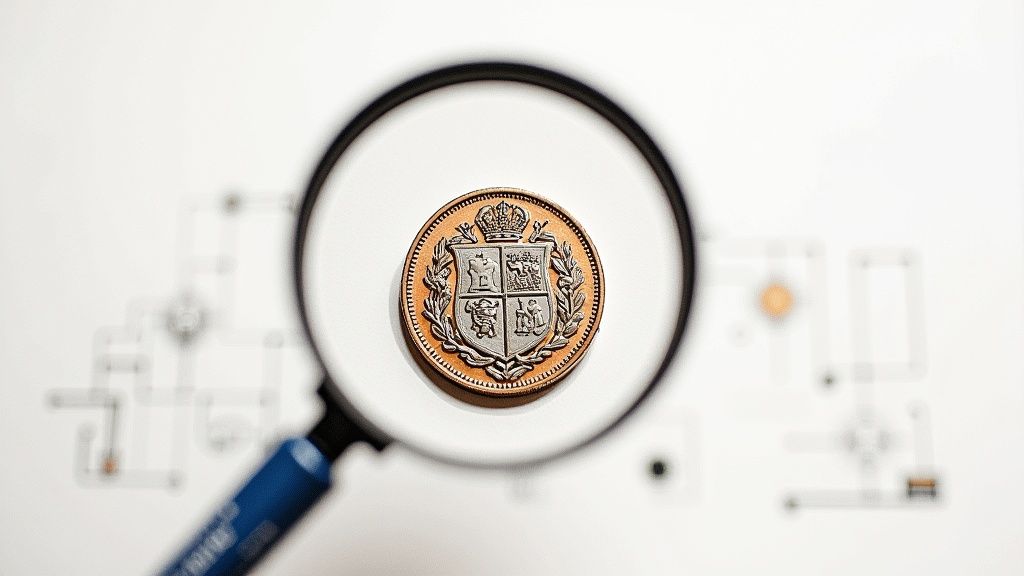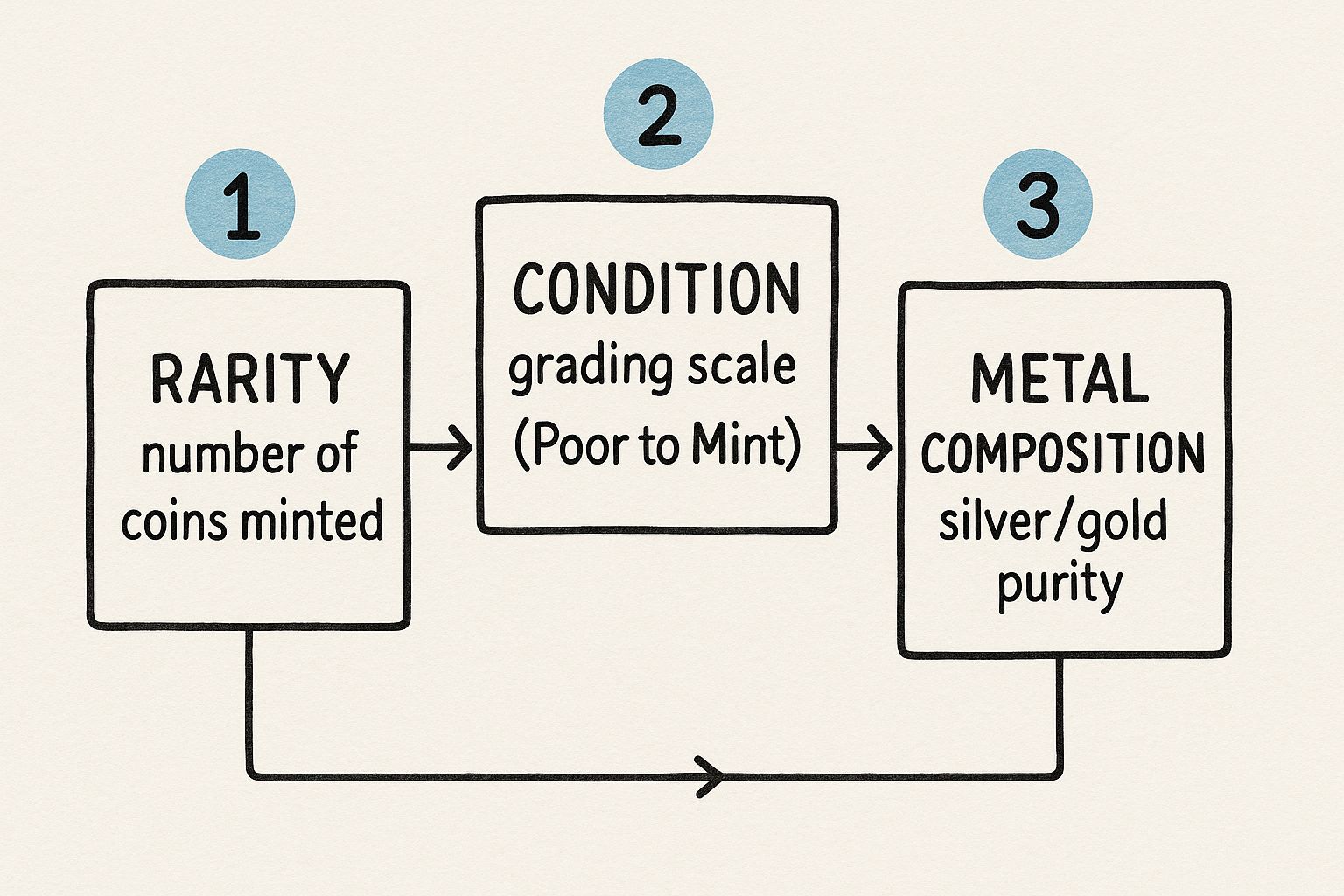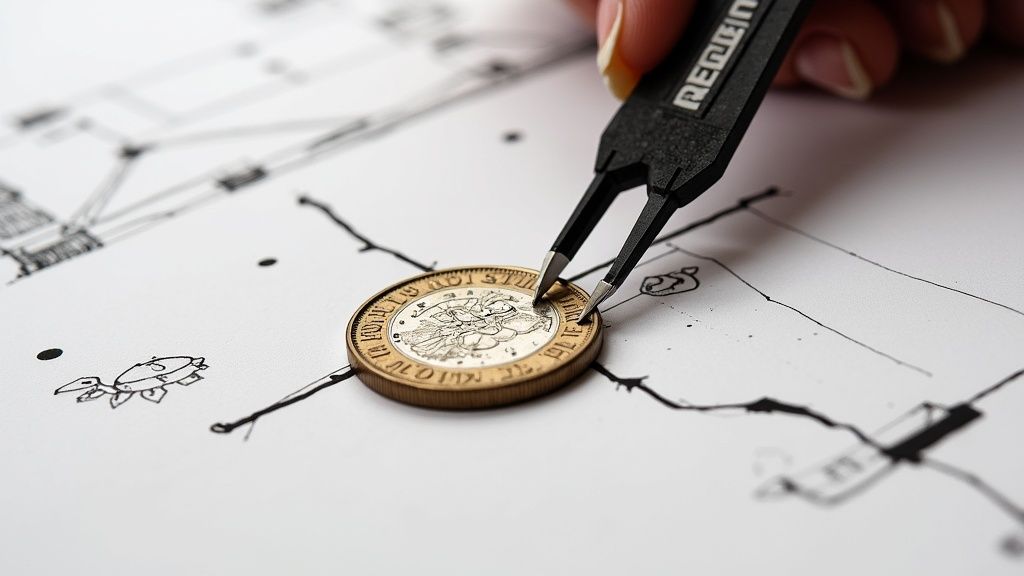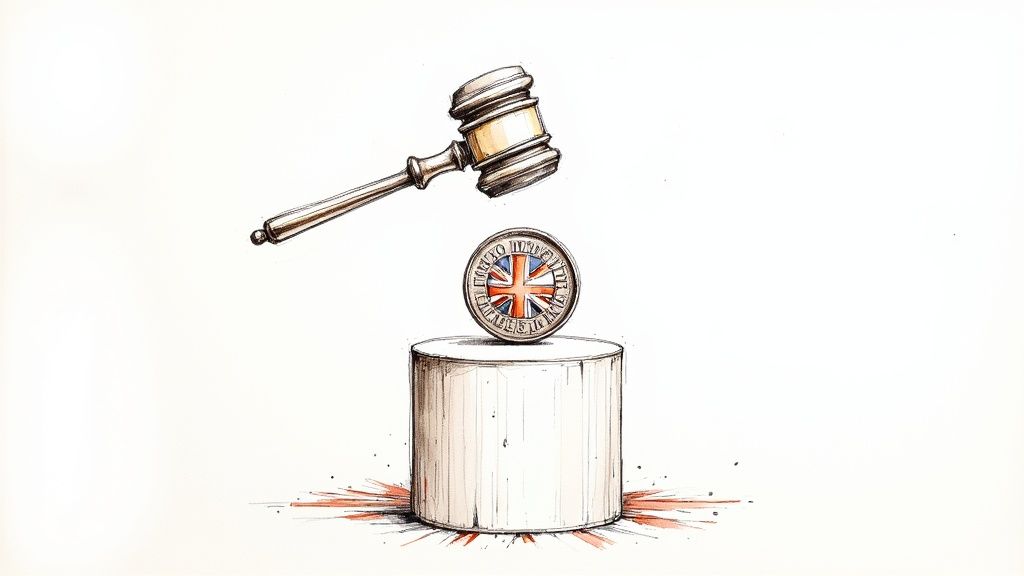So, you’ve unearthed a tin of old coins and the big question is, are they worth anything? It’s a moment of excitement for anyone, but working out if you have a genuine treasure or just some old pocket money can feel a bit daunting.
Figuring out what your coins are worth is about more than just a quick search online. To get a proper coin valuation in the UK, you need to think like a collector. It all comes down to a few key things: how rare it is, what condition it’s in, its history, and what metal it’s made from. Let's break it down.
Decoding the Value of Your British Coins

The real value of any coin lies in a blend of factors that seasoned numismatists (that’s the expert term for coin collectors) have used for decades. Understanding these basics is your first step. It’s what stops you from getting your hopes up over a common coin listed for a silly price on eBay, or worse, accidentally selling a rare gem for pennies.
At the end of the day, a coin's value is driven by what a collector is willing to pay for it. And what they're willing to pay for depends on these four crucial elements.
The Four Pillars of Coin Value
Think of coin valuation as resting on four essential pillars. Each one is just as important as the next in determining whether you have a coin worth its face value, or something far more special.
- Rarity: This one is simple supply and demand. How many were ever minted? A coin with a tiny mintage, like the famous 2009 Kew Gardens 50p, is always going to be more sought-after than a coin produced by the hundreds of millions. Fewer coins available means more collectors chasing them.
- Condition (or Grade): How much life has the coin had? A coin that looks like it just left the Royal Mint—crisp, with sharp details and no scratches—is called 'uncirculated' and will always fetch a higher price than its worn-down, heavily circulated counterpart.
- Demand & Historical Significance: Does the coin have a story? Some coins are in high demand because they connect us to a pivotal moment in our past or feature a design that people love. To get a feel for this, you can explore a brief history of British coins and see how major events shaped our currency.
- Metal Content: What's it made of? For many older coins, like a gold Sovereign or any pre-1947 silver coin, their value is underpinned by the precious metal they contain. This 'bullion value' acts as a price floor – the coin will never be worth less than its weight in gold or silver.
To give you a clearer picture, I've put together a quick table summarising these core valuation factors with some real-world UK examples.
Core Factors in UK Coin Valuation
| Valuation Factor | What It Means for Value | Real UK Coin Example |
|---|---|---|
| Rarity | Fewer coins minted equals higher potential value due to scarcity. | The 1933 George V Penny is legendary; only about 7 were made, making it exceptionally valuable. |
| Condition (Grade) | A pristine, uncirculated coin will always be worth significantly more than a heavily worn one. | An uncirculated 1983 'New Pence' 2p can be worth hundreds, while a standard one is worthless. |
| Historical Significance | Coins tied to major events or with minting errors attract strong collector interest. | 'Mule' coins, like the 2008 dateless 20p, which was struck with the wrong die, are highly sought after. |
| Metal Content | The intrinsic value of the precious metal (gold, silver) provides a baseline price. | A gold Sovereign from any year is always worth at least its weight in gold, regardless of condition. |
This table helps illustrate how these different elements come together. Two coins that look similar at a glance, like a pair of Victorian pennies, can have wildly different values. One might be a common year and heavily worn, worth maybe a pound or two. The other could be from a rarer year, in near-perfect condition, and be worth hundreds.
A coin's story is just as important as its physical state. A seemingly ordinary coin can become highly valuable if it represents a significant historical event, a minting error, or a short-lived reign.
Grasping these fundamentals is the essential first step before you start digging deeper into your own collection. It gives you the lens through which to view each coin and begin to appreciate what makes it special.
How To Identify And Research Your Coins
Before you can even begin to think about what your coin might be worth, you need to play detective. The very first job is to figure out precisely what you're holding. This is the foundational step that transforms a simple piece of metal into an object with a story and, hopefully, a bit of value. It's all about learning to read the clues on the coin's surfaces.
Every British coin is a tiny piece of history, carrying vital information for you to uncover. Start with the most obvious features: the date and the monarch's portrait. A shilling from Queen Victoria's reign is a world away from a modern commemorative 50p, and simply identifying the ruler gives you an immediate timeframe to work with.
From there, you need to look closer. Examine the specific design elements, any inscriptions, and even the tiniest of letters. These are often mint marks, and they tell you exactly where the coin was made – a detail that can dramatically alter a coin's rarity and value.
For a more detailed guide on spotting these crucial features on older pieces, have a look at our post on how to identify old coins provides expert tips for beginners.
Deciphering Your Coin's Details
Once you've gathered the basics—monarch, date, and denomination—it's time to dig a little deeper with some reliable resources. It can be tempting to jump straight onto eBay, but be warned: the prices you see there can be wildly misleading and are best avoided at this stage. Instead, turn to established numismatic tools that the experts use.
This infographic breaks down the three core pillars that work together to determine a coin's final valuation.

As you can see, a coin's rarity, its physical condition, and its metal composition are all interconnected. Each one plays a crucial role in the final assessment.
To start your own research, there are a few key resources that are indispensable for UK collectors:
- Online Coin Catalogues: Websites like Numista or even The Royal Mint's own archives have fantastic, extensive databases. You can search by date, metal, or design to pinpoint the exact coin you have.
- Reference Books: For anyone getting serious about collecting, publications like the annual Coin Yearbook by Token Publishing are invaluable. They provide detailed mintage figures and up-to-date market prices.
- Reputable Dealer Websites: Many established UK coin dealers have excellent online resources and articles that can help you identify both common and rare varieties.
Remember, accurate identification is all about precision. You don't just have a "George V penny." You might have a "1919 KN George V penny," with the 'KN' indicating it was struck at the Kings Norton Metal Company. It's a tiny detail, but it can make all the difference to the value.
Using Official Resources
The Royal Mint website is another fantastic tool for understanding the technical specifications of British coins. You can find everything from their exact weight and diameter to their metal composition. Knowing these official details is one of the best ways to spot fakes or unusual varieties.
For instance, this kind of official data confirms whether the coin in your hand matches the records. This is a critical part of the authentication and valuation process. By cross-referencing your coin's physical characteristics with official data, you build a solid case for its identity, which paves the way for a much more accurate appraisal down the line.
Getting to Grips with Coin Condition and Grading

You could have two coins that look identical at first glance, struck in the very same year, yet one is worth £5 and the other fetches £500. What gives? Almost every time, that huge difference boils down to one crucial thing: condition.
In the world of coin valuation here in the UK, the physical state of a coin—its 'grade'—is everything. This isn't just about a coin being "old" or "shiny." Grading is a very specific language collectors use to describe the amount of wear a coin has seen since it left the mint.
Think about it. A coin that was popped into a collection the day it was made will still have sharp, crisp details. But one that’s been rattling around in pockets and tills for decades will be worn smooth. That distinction can mean the difference between pocket change and a serious collectible.
Common UK Coin Grades Explained
Getting your head around the key grading terms we use in the UK is vital. The system has its nuances, but knowing the main categories will let you make a realistic first guess at what you've got.
- Uncirculated (UNC): This is the top of the pyramid. The coin looks just as it did the moment it was minted, with zero signs of wear. It still has its original gleam, or mint lustre, and every detail is razor-sharp.
- Extremely Fine (EF): A coin that's seen very little action. You might spot the slightest wear, but only on the very highest points of the design. Much of that original lustre is still there, and the details are crystal clear.
- Very Fine (VF): This coin has definitely been in circulation. There’s moderate wear on the high points, and while the major details are still clear, some of the finer points are starting to soften up.
Learning to spot these differences is a game-changer. For a much closer look at the specific criteria, our expert guide to British numismatic value breaks it all down with more detail and pictures.
The impact of condition on price is massive. For example, some special 50p coins from the 2012 London Olympics series, like the Aquatics one, can sell for over £800 in top condition. Similarly, error coins, such as the famous 1983 2p with the 'new pence' wording, can be valued at well over £1,000—but only if their condition is up to scratch.
The Cardinal Sin of Coin Collecting
If you remember just one thing from this guide, make it this: never, ever clean your coins. I know it’s tempting to polish up a tarnished silver shilling or scrub the muck off an old penny to make it look 'new'. But trust me, it’s the single most destructive thing you can do to a coin's value.
Cleaning strips away a coin's natural patina—that subtle toning that develops over decades. Collectors prize this originality. Polishing, scrubbing, or using chemicals leaves behind microscopic scratches and an unnatural shine that any experienced eye can spot from a mile away, instantly killing its numismatic value.
Even a gentle, well-meaning wipe can turn a valuable piece into something worth little more than its face value or scrap metal price. Scratches, nicks on the rim, and any hint of cleaning are huge red flags for collectors.
Always handle your coins by their edges and keep them in proper, non-reactive holders. You'll be preserving their condition and, ultimately, their worth.
The Real Story Behind Rare and Valuable Coins
When you’re trying to figure out what a coin is worth, its condition is only half the story. The other, often more exciting half, is its rarity. This is what can turn a simple piece of metal into a seriously coveted treasure.
But what actually makes a coin rare? It’s not always about age. It’s a fascinating mix of low production numbers, weird historical events, and sometimes, just a complete accident at the mint.
The most obvious place to start is with the mintage figures. This is simply how many coins of a particular type were struck in a given year. The fewer that were made, the more collectors will fight over them. It's basic supply and demand, and it’s why a common Victorian penny is worlds apart from a true numismatic prize.
What Creates a Genuinely Rare Coin
Low mintage is a great starting point, but it's not the full picture. Many of Britain’s most sought-after coins are rare because of something unique that happened, often at The Royal Mint.
- Withdrawn Designs: Every so often, a coin is designed and struck, but for political or other reasons, it’s pulled before it ever reaches the public. These are instant rarities.
- Famous Error Coins: Mistakes happen, even at the mint. A coin might be struck using the wrong design or on the wrong type of metal blank. The few ‘error’ coins that slip past quality control are snapped up by collectors for their uniqueness.
- Historical Meltdowns: Throughout history, especially in times of war or economic crisis, old coins were often recalled and melted down for their metal. A coin that was once common could suddenly become incredibly scarce.
A fantastic example of a withdrawn design is the 1937 Edward VIII sovereign. Edward abdicated before his coins could be issued, so almost all were destroyed. The few pattern pieces that survived are now legendary in the coin world.
When History and Scarcity Collide
The coins that fetch the biggest prices are almost always the ones where incredible rarity meets a compelling story. These aren't just collection-fillers; they're a physical link to a specific moment in British history.
A coin is more than just currency; it's a historical document. The story behind why it's rare—a military victory, a change in monarchy, or a minting blunder—is often what gives it its soul and a significant portion of its value.
You can see this link between story and price in the UK's most famous coins. The 1933 George V penny, with only seven known examples, can fetch around £86,400. The almost mythical 1937 Edward VIII Gold Sovereign, with just six known to exist, can hit an eye-watering £1,000,000.
Then you have coins like the 1703 Queen Anne 'Vigo' Five Guineas, struck from Spanish treasure captured in battle, which has sold for £845,000. You can dive deeper into Britain's most valuable coins and their stories to see just how powerful this combination is.
Getting your head around this collector mindset is vital if you want to perform a coin valuation UK experts would take seriously. It’s not just about identifying the coin, but understanding why so few of them are left today.
Finding a Professional Coin Appraiser in the UK

While online tools and guidebooks are fantastic for your initial research, there comes a point where you simply need an expert eye. If you've inherited a large collection or stumbled upon a coin you genuinely believe is rare and valuable, it’s time to seek a professional coin valuation in the UK.
An expert can spot the subtle nuances in grading and identify rare varieties that an untrained eye would easily miss. This is the moment you move beyond hobbyist research and get a proper, market-ready assessment. A professional appraiser brings clarity, especially when the stakes are high—like getting insurance cover or preparing for a high-value sale.
Where to Find Reputable UK Experts
Finding a trustworthy appraiser is absolutely crucial. Your first port of call should always be established numismatic organisations. These bodies hold their members to high professional standards and offer directories of vetted experts.
- The British Numismatic Trade Association (BNTA) is the best place to start. Its members are all reputable dealers who must adhere to a strict code of ethics.
- Specialist Auction Houses with dedicated coin departments (think Spink or Dix Noonan Webb) employ some of the world's leading experts.
- Local Coin Shops and Fairs can be fantastic resources. Just be sure to check for BNTA membership or a long history of positive reviews to ensure you’re dealing with someone credible.
It’s important to understand the difference between a quick verbal estimate and a formal written valuation. The first is usually a free, informal opinion on what a dealer might offer you for the coin. The second is a detailed, documented appraisal, typically done for a fee, which you’ll need for insurance or probate.
What to Expect During an Appraisal
A professional appraiser will do far more than just glance at your coin. They'll meticulously examine its authenticity, grade its condition, check for rare varieties, and cross-reference it against current market data and recent auction results. It’s a complex process that draws on years of specialist knowledge.
Historical context, for example, is vital. The value of British coins reflects huge shifts in the country's monetary past. Before decimalisation on 15th February 1971, the UK used the old system of pounds, shillings, and pence, which can be baffling today. An expert understands the significance of these pre-decimal coins and how their value has evolved over centuries. You can learn more about the history of British coin values on Statista.com.
When you meet with an appraiser, don't be afraid to ask questions. Ask about their experience with your type of coin and how they arrived at their valuation. A reputable professional will be transparent about their process and happy to explain their reasoning, making sure you leave with a clear and fair understanding of your coin’s true worth.
A Few Final Questions About Valuing Your UK Coins
As you start to pin down the value of your coins, a few common questions almost always pop up. The world of coin collecting has its quirks, so let's tackle some of the most frequent queries we hear from fellow collectors here in the UK.
Getting these last few details straight will give you the confidence you need to make the right decisions for your collection, whether you're planning to sell, hold, or just appreciate what you've got.
Are My Modern Commemorative UK Coins Worth Anything?
This is probably the number one question people ask. We all see those colourful 50p or £2 coins in our change and wonder if we've struck gold. The honest answer is: it depends, but mostly, they're just worth face value.
However, there are exceptions, and they are almost always down to mintage figures. Certain designs with a very low production run become instant hits with collectors. The most famous example, of course, is the 2009 Kew Gardens 50p. With only 210,000 minted, it can easily sell for over £200. The value for modern coins is a mix of rarity, the popularity of the design, and, critically, its condition.
A coin's value isn't just about the design on its face, but how well it has been looked after. A pristine 'Brilliant Uncirculated' version of a coin, often bought in a special presentation pack, will always be worth more than the exact same one that’s been rattling around in someone’s pocket.
Where’s the Best Place to Sell My Coins in the UK?
Once you have a solid idea of what your coin is worth, you need to find the right home for it. Where you sell really depends on the coin's value and how much time you're willing to invest in the process.
- High-Value Coins: If you have something truly rare or valuable, your best options are a specialist numismatic auction house or a reputable dealer. They have established networks of serious collectors who are prepared to pay the right price.
- Moderate-Value Coins: Online marketplaces like eBay can be a good shout. The key here is to take excellent photos and write a detailed, accurate description. Just don't forget to factor in the platform's fees, as they can take a decent chunk of the final sale price.
- General Collections: For a mix of coins, local coin clubs or fairs are fantastic. You get to meet other enthusiasts and dealers face-to-face, which is often the simplest way to get a fair price without the admin of selling online.
How Does the Price of Gold and Silver Affect My Coin's Value?
For any coin made of precious metal—think gold Sovereigns or any British silver coins minted before 1947—the metal itself gives the coin a baseline value. We call this its bullion value.
This means the coin can never be worth less than the current market price of the gold or silver it contains. It’s a safety net. For a genuinely collectible coin, though, its numismatic value (based on its rarity, condition, and collector demand) is often much, much higher. The bullion price is the floor, not the ceiling.
And a final, crucial tip: whatever you do, do not clean your old coins. It’s so tempting to polish up a tarnished silver coin, but you will almost certainly destroy its value. Collectors prize the natural surface, or patina, that develops over time, and removing it is the quickest way to turn a valuable piece into scrap metal.
At Cavalier Coins Ltd, we're passionate about helping collectors at every stage of their journey. Whether you're trying to identify a single inherited coin or looking to sell an entire collection, our expertise is at your service. Come and explore our extensive selection of rare and interesting world coins and banknotes by visiting us at https://www.cavaliercoins.com.

